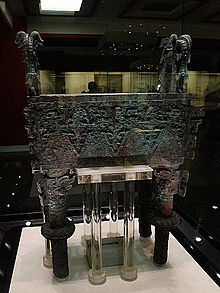
Back Bronzes rituals xinesos Catalan Chinesische Ritualbronzen German Bronces rituales chinos Spanish Bronzes chinois French Objek perunggu ritual Tiongkok ID Bronzi rituali cinesi Italian 中国の青銅器 Japanese ചൈനീസ് ആചാര വെങ്കലങ്ങൾ Malayalam Chińskie brązy rytualne Polish Objetos de bronze chineses usados em rituais Portuguese

From c. 1650 BC, elaborately decorated bronze vessels were deposited as grave goods in the tombs of royalty and nobility during the Chinese Bronze Age. Documented excavations have found over 200 pieces in a single royal tomb. They were produced for an individual or social group to use in making ritual offerings of food and drink to his or their ancestors and other deities or spirits. Such ceremonies generally took place in family temples or ceremonial halls over tombs. These ceremonies can be seen as ritual banquets in which both living and dead members of a family were supposed to participate. Details of these ritual ceremonies are preserved through early literary records. On the death of the owner of a ritual bronze, it would often be placed in his tomb, so that he could continue to pay his respects in the afterlife; other examples were cast specifically as grave goods.[2] Indeed, many surviving examples have been excavated from graves.
The bronzes were likely not used for normal eating and drinking; they represent larger, more elaborate versions of the types of vessels used for this, and made in precious materials. Many of the shapes also survive in pottery, and pottery versions continued to be made in an antiquarian spirit until modern times. Apart from table vessels, weapons and some other objects were made in special ritual forms. Another class of ritual objects are those, also including weapons, made in jade, which was probably the most highly valued of all, and which had been long used for ritual tools and weapons, since c. 4500 BC.[2]

At least initially, the production of bronze was probably controlled by the ruler, who gave unformed metal to his nobility as a sign of favour.[3][4] The technology of bronze production was described in the Kao Gong Ji, compiled some time between the 5th and 3rd centuries BC.[4]
- ^ "Altar Set". The Metropolitan Museum of Art. Retrieved 2017-11-19.
- ^ a b Rawson (2007), pp. 44–60.
- ^ Rawson (2007), pp. 33–34.
- ^ a b Pare, Sascha (10 August 2022). "Researchers decode metal-making recipes in ancient Chinese text". The Guardian.